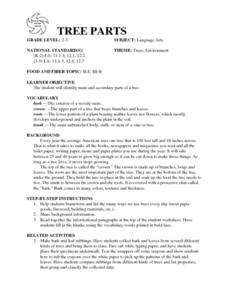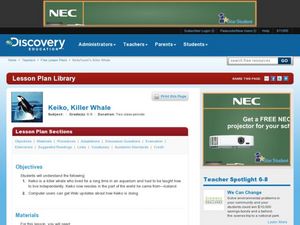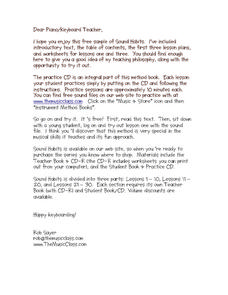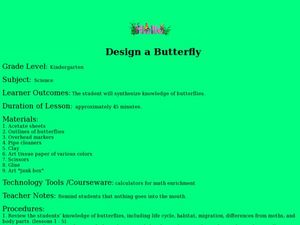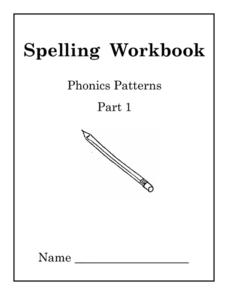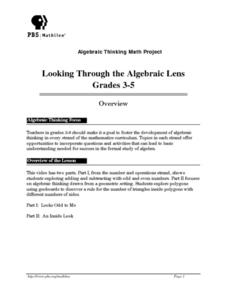Curated OER
TREE PARTS
The student will identify main and secondary parts of a tree.1. Help students brainstorm and list the many ways we use trees every day (most paper goods, firewood, building materials, etc.). 2. Share background information. 3. Read...
Curated OER
Prepositions Used as Adverbs
Sixth graders discuss with the teacher what a prepositional phrase when used as an adverb describes. They then understand that adverb phrases will answer the questions: where, when, in what way, or to what extent. They then do student...
Curated OER
What's the Big Idea at Hogwarts? part II
In this literacy and spelling activity, students read the groups of words from the book 'Harry Potter.' Students determine what the sets of words have in common.
Curated OER
Where Do I Belong? - Part Two
Students organize library books using their library catalogue numbers. In this library books lesson, students receive four books to identify and then place in order according to their library information.
Curated OER
Writing a Comparison/Contrast Paragraph: Using Vivid Verbs
In this vivid verbs worksheet, students complete three activities that help them use strong, vivid verbs in the comparison and contrast writing.
Curated OER
New York State Testing Program: English/Language Arts Book 2, Grade 3 2010
This 3rd grade English/Language Arts standardized test practice worksheet includes multiple choice questions, short answer, and a paragraph to correct. The passage intended for the multiple choise section is not included.
Curated OER
One Size Fits All, Part 1
Can you tell how tall someone is just by looking at their feet? In this activity, young mathematicians measure their height, arm span, and foot size, graph their findings, and answer questions about how these measurements are related....
Curated OER
Questions for The Book The Giving Tree
Are you studying Shel Silverstein? Focus on The Giving Tree and talk about selflessness in your class. In this online interactive quiz, pupils respond to eleven multiple-choice reading comprehension questions on this particular...
Curated OER
Using Each Trait to Improve Student Writing
Students examine examples of the qualities of good writing skills and discuss how each of the traits add to the process of good writing. A variety of excerpts from literature provide samples for the exploration.
Curated OER
Fall 2004 Midterm Exam #1, Parts A & B
First year physics learners show what they know about electric potential, circuits, power, current, and voltage on this midterm exam. It consists of a multiple choice section, some true or false questions, and two multi-step problems to...
Curated OER
3-D Figures Part 1
Elementary schoolers explore 3-D shapes. They transition from thinking of shapes as only 2-D. Pupils read Cinderella as a launching activity for their upcoming adventure, and explore a new world of 3-D shapes in this introductory lesson.
Curated OER
Prepositions, Using Prepositions After Adjectives-1
In this foreign language worksheet, students select the most appropriate preposition to fill in the blank. They read 10 sentences, and select choice a, b, or c.
Curated OER
Keiko, Killer Whale
Middle schoolers will create a children's book on Keiko, the killer whale, that was rehabilitated and returned to the wild after living in an aquarium. In small groups, they conduct internet research to find out the history and current...
Music Class
Sound Habits
Hear ye! Hear ye! Encourage your young keyboard/piano players to develop sound habits with a resource packet that introduces a dynamic learning method. The free sample lessons, part of a for-purchase program, are designed to be used in a...
Curated OER
What is the Setting of a Story?
First graders explore the concepts of what setting is and how it's determined in a story. They play the KidWorks program to help facilitate the setting in a story. They use resources such as a picture dictionary or word wall to find and...
Curated OER
The Tale of Peter Rabbit
Wow! Here is a most-impressive series of lessons and activities that revolve around the classic story, The Tale of Peter Rabbit. The purpose of the lessons are to provide an agricultural theme in the reading, writing, and science...
Curated OER
Design a Butterfly
Students access prior knowledge of butterflies. In this butterfly lesson plan, students create butterflies and compare and contrast their butterflies. Students describe the various body parts.
Kathryn J. Davis
Spelling Workbook: Phonics Patterns
Set your pupils straight with spelling and sounds by using these materials for practice. Included here are three booklets and workbooks that cover just about any sound or blend you could think of!
Baylor College
Neurotransmitters Contain Chemicals
Human body systems young scholars play a card game, "Locks & Keys" in order to learn that neurotransmitters carry a message from one neuron to another by fitting into a receptor site on the receiving nerve cell. While this activity...
Curated OER
Looking Through the Algebraic Lens
Students work with rectangles to find generalizations for adding and subtracting odd and even numbers in part one of the lesson. In part two, students use geoboards to construct polygons, look for patterns, and find a general rule.
Curated OER
Physical Setting: Physics Exam 2004
Twelve pages of mostly multiple-choice questions comprise this comprehensive New York Regents physics exam. It covers an entire year's worth of physics curriculum and requires about three hours for completion. Review the questions to...
Curated OER
Teaching "A Week in the Woods"
The book, A Week in the Woods is the focus of the very interesting language arts lesson presented here. After the book has been read, learners engage in study of certain parts of the book in order to gain a better understanding of how...
Baylor College
Rainbow in the Room
Uncover the science behind the beautiful phenomena of rainbows with a simple demonstration. Shine light through different-sized containers of water as young scientists learn that rainbows occur when visible light is split up into its...
Baylor College
What Is a Neuron?
Your class won't get on your nerves while doing this modeling activity! After teaching the structure and function of a neuron using the included diagrams, give individuals some clay and chenille stems so that they can make their own...
